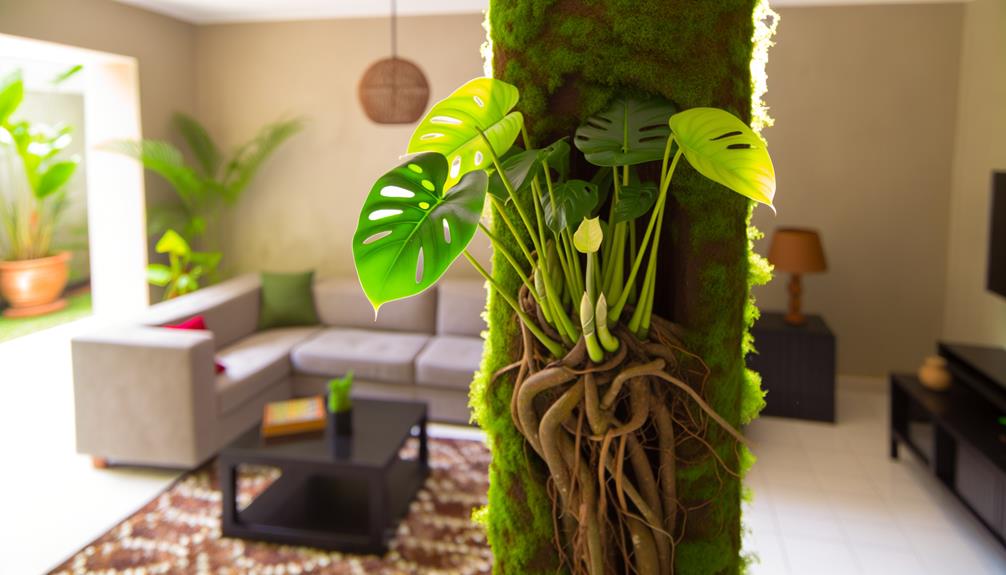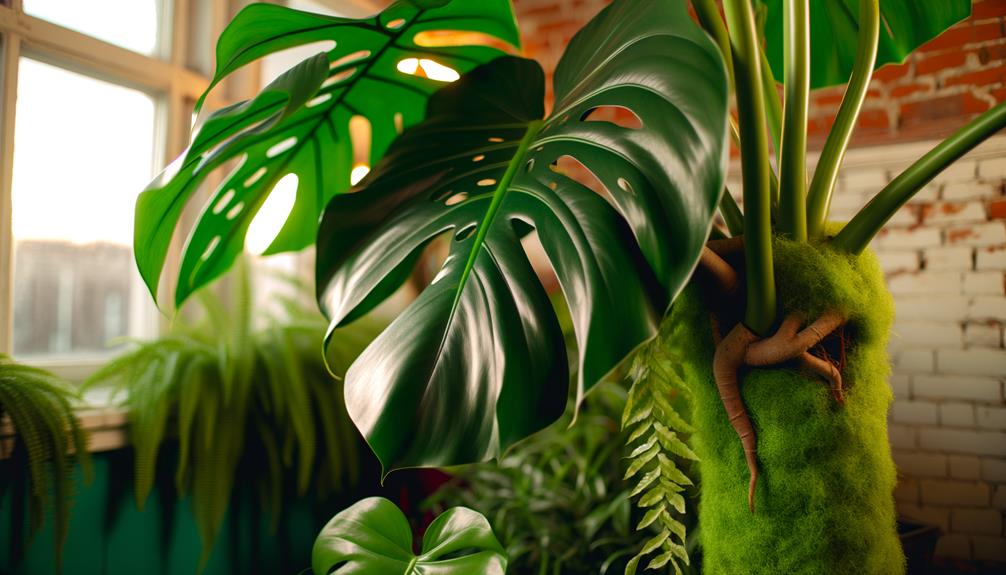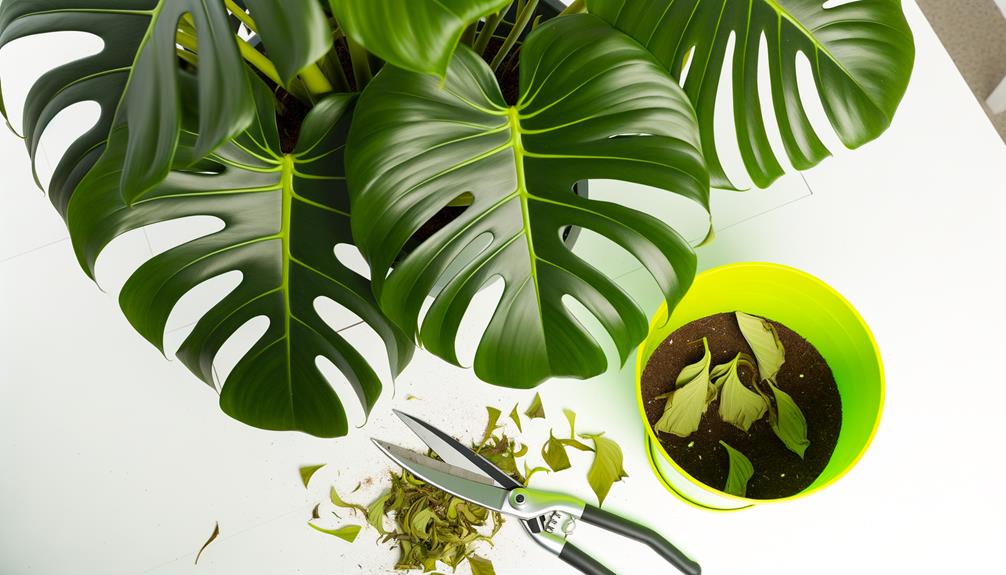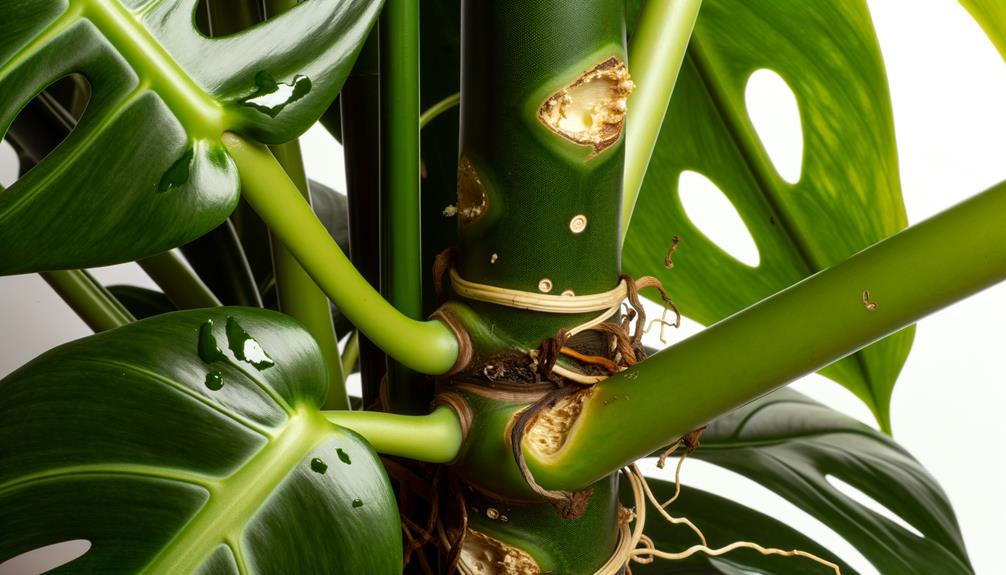How to Support Monstera Plant? Best Methods!
To support your Monstera plant, select a sturdy structure like a moss pole or bamboo stake. These materials mimic its native habitat, aiding aerial roots in moisture absorption and nutrient uptake.
Secure the stems with flexible plant ties to avoid damaging roots. Pruning helps balance growth and enhances light penetration.
Use sterilized shears to remove dead or yellow leaves, and focus on thinning dense areas. Regularly apply a balanced, water-soluble fertilizer with a 20-20-20 NPK ratio and monitor for pests or nutrient deficiencies.
There’s much more to explore about proper Monstera care and support systems.

Key Takeaways
- Use sturdy materials like moss poles, trellises, or bamboo stakes to provide robust support.
- Secure stems with flexible plant ties to avoid damaging aerial roots and promote upright growth.
- Opt for tall support structures to accommodate the Monstera’s future vertical growth.
- Regularly prune and tie stems to maintain shape, light exposure, and climbing behavior.
- Apply balanced fertilizer every 4-6 weeks in spring and summer to ensure healthy growth.
Understanding Monstera Growth

To understand Monstera growth, you need to analyze how its aerial roots and fenestrated leaves adapt to varying light and moisture conditions in its native tropical environment.
Aerial roots anchor the plant to trees, absorbing moisture and nutrients from the air. These roots also help the Monstera climb towards light sources, optimizing photosynthesis.
Fenestrated leaves, with their unique perforations, reduce wind resistance and allow sunlight to reach lower leaves.
In their natural habitat, Monsteras thrive under filtered light and high humidity, mimicking the understory of tropical forests. By understanding these adaptations, you can create ideal growing conditions, ensuring your Monstera’s health and vigorous growth.
It’s essential to balance light and moisture to replicate its native environment accurately.
Choosing the Right Support
Selecting the suitable support structure for your Monstera is crucial to facilitate its natural climbing behavior and guarantee optimal growth. Opt for sturdy materials like moss poles, trellises, or bamboo stakes, which can withstand the plant’s weight and provide a textured surface for aerial roots to latch onto.
Make sure the support is tall enough to accommodate future growth, ideally reaching at least 3-4 feet. Choose materials that retain moisture, like a moss pole, to mimic the plant’s native tropical environment and enhance root attachment.
Additionally, consider the support’s stability; it should be anchored firmly in the potting mix to prevent tipping. This careful selection promotes robust growth and overall plant health, ensuring your Monstera thrives.
Staking Your Monstera

Properly staking your Monstera guarantees it maintains an upright form and promotes vigorous growth by providing essential support for its climbing habit.
Start by choosing a sturdy stake, like a moss pole or bamboo stick, which mimics the plant’s natural environment. Insert the stake into the soil near the plant’s base, ensuring it’s deep enough for stability.
Use flexible plant ties to gently secure the Monstera’s stems to the stake, avoiding damage to the aerial roots. Space the ties evenly, allowing the plant to grow naturally.
Monitor growth regularly, adjusting ties as needed to accommodate new stems. This method supports the plant’s structural integrity, aiding in nutrient distribution and maximizing photosynthesis efficiency.
Training Techniques
To effectively train your Monstera plant, you should focus on techniques like staking for vertical growth, using moss poles for aerial root support, and applying precise pruning and tying methods. These approaches guarantee the plant maintains structural integrity and best growth patterns.
Let’s examine each technique to understand their impact on the Monstera’s health and aesthetics.
Staking for Vertical Growth
When aiming to support your Monstera plant’s vertical growth, implementing staking techniques like moss poles or trellises can effectively train the vines to climb upward, maximizing light exposure and promoting robust development. These structures not only provide physical support but also mimic the plant’s natural habitat.
| Staking Method | Benefits |
|---|---|
| Moss Poles | Retain moisture, support aerial roots |
| Trellises | Provide sturdy structure, easy to install |
| Bamboo Stakes | Cost-effective, natural appearance |
| Wire Cages | Durable, customizable shapes |
| Wooden Lattice | Aesthetic appeal, versatile |
Tie the stems gently to the stakes using soft ties to prevent damage. Regularly check and adjust as the plant grows to ensure ideal alignment and support.
Using Moss Poles
Incorporating moss poles into your Monstera care routine involves strategically positioning them to support and guide the aerial roots and vines as they climb. Begin by selecting a sturdy moss pole, which mimics the natural environment of Monstera’s native tropical habitats.
Insert the pole into the pot, ensuring it’s firmly anchored in the soil. As the Monstera grows, gently weave the aerial roots and vines around the pole, encouraging them to attach. The moss retains moisture, promoting root adhesion and nutrient absorption.
Regularly mist the pole to maintain an ideal humidity level. By creating a vertical structure, you facilitate better light exposure and airflow, enhancing the plant’s overall health and development. This method effectively trains the Monstera, optimizing its natural climbing tendencies.
Pruning and Tying Tips
Properly trimming and securing your Monstera not only maintains its aesthetic appeal but also directs its growth, guaranteeing a robust and healthy structure. When trimming, use sterilized shears to eliminate dead or yellowing leaves. Trim just above a node to promote new growth. For securing, use soft plant ties to gently fasten stems to a support structure. Avoid tight knots to prevent stem damage.
| Trimming Tips | Securing Techniques |
|---|---|
| Use sterilized shears | Use soft plant ties |
| Eliminate dead leaves | Fasten to support |
| Trim above a node | Avoid tight knots |
Following these techniques guarantees your Monstera remains healthy and visually appealing. Regular maintenance is crucial to a thriving, vibrant plant.
Pruning for Shape

To maintain an attractive and healthy Monstera, begin by strategically pruning its stems to encourage a balanced growth pattern and optimal light penetration. Use sterilized pruning shears to remove any dead or yellowing leaves, cutting at the base of the stem.
Focus on thinning dense areas to prevent overcrowding, which can lead to poor air circulation and increased vulnerability to pests. Prune just above a node where new growth is likely to emerge, fostering a fuller appearance. Remove any leggy or excessively long stems to uphold a compact shape.
Make sure to prune during the plant’s active growing season, typically spring or summer, to minimize stress and promote swift recovery. Regular pruning will help your Monstera thrive.
Watering and Feeding
To maximize your Monstera’s health, you need to establish a peak watering schedule, which typically involves watering when the top inch of soil feels dry. Monitoring soil moisture levels and adjusting based on seasonal changes will prevent overwatering or underwatering.
Additionally, understanding the plant’s nutrient needs and providing a balanced fertilizer bi-monthly during the growing season will support vigorous growth.
Optimal Watering Schedule
Achieving an ideal watering schedule for your Monstera plant involves understanding its unique hydration needs and monitoring soil moisture levels meticulously. You should water your Monstera when the top 2-3 inches of soil feel dry to the touch. Insert your finger into the soil to gauge this accurately.
Overwatering can lead to root rot, characterized by yellowing leaves and a musty odor. Conversely, underwatering will cause leaf curling and browning edges. Utilize a well-draining soil mix to prevent water stagnation.
Maintain consistent watering, adjusting frequency based on seasonal variations; water more in summer and less in winter. Always use room temperature, filtered water to avoid shocking the plant’s roots. This careful approach ensures ideal hydration and robust growth.
Nutrient Requirements
Nurturing your Monstera plant involves a balanced approach to both watering and feeding. You’ll want to water when the top inch of soil feels dry, guaranteeing the soil is consistently moist but not waterlogged. Overwatering can lead to root rot, a condition harmful to Monstera health.
For feeding, use a balanced, water-soluble fertilizer with a 20-20-20 NPK ratio every 4-6 weeks during the growing season (spring and summer). This guarantees an adequate supply of nitrogen, phosphorus, and potassium, essential for foliage development and overall plant vitality.
During the dormant period (fall and winter), reduce feeding to once every two months, as the plant’s nutrient uptake decreases. This approach optimizes growth and prevents nutrient imbalances.
Monitoring Plant Health

Regularly evaluating the health of your Monstera plant involves inspecting its leaves, stems, and roots for signs of pests, diseases, or nutrient deficiencies. Check the leaves for yellowing, browning, or unusual spots, which could indicate fungal infections or nutrient imbalances.
Examine the stems for any soft, mushy areas that might suggest rot. If possible, inspect the roots; healthy roots are white or light tan and firm to the touch. Look for pests like spider mites, aphids, or scale insects, which can cause significant damage.
Additionally, monitor for signs of nutrient deficiencies such as stunted growth or pale leaves. Keeping a close eye on these indicators will help you maintain a thriving Monstera plant.
Conclusion
With your newfound expertise, your Monstera will become the envy of every plant enthusiast. By selecting the perfect support, skillfully staking, and carefully training, you’ve set the stage for its impressive growth.
Pruning guarantees it maintains its stunning shape, while precise watering and feeding fuel its unstoppable importance. Monitor its health like a scientist, and you’ll witness your Monstera transform into a botanical marvel, rivaling even nature’s most untamed creations.
Your green-thumb prowess is truly unmatched!






